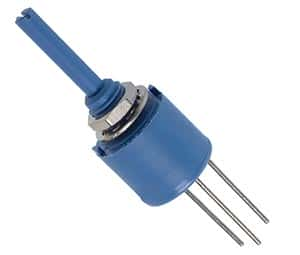The electronics industry uses many resistance-based components. While in some of them, the resistance is fixed, for others, the user can change the resistance. Potentiometers fall in the second category. Very often, they have a mechanical arrangement that allows the user to change the resistance value manually. Unlike the fixed resistor type components, potentiometers act as variable resistors.
The most common use of a potentiometer is to divide an applied voltage. Therefore, these components serve a dual purpose. On one hand, they help to adjust the voltage output within the circuit, while on the other, they can accurately measure the electric potential. This is the reason for their name being potentiometer. The typical construction of a potentiometer has a resistive element with a wiper. Adjusting the position of the wiper on the resistive element allows the potentiometer to deliver a continuously variable voltage output as a signal on its wiper. It is necessary to add that potentiometers are passive components. That means, unlike active elements, potentiometers do not require additional circuitry or a power supply to operate.
According to physical laws, the resistance of an object depends on many factors, one of them being its length. With all other parameters remaining constant, the resistance of an object will vary directly as its length does. Therefore, two objects made of the same material, with the same cross-sectional area, will exhibit different resistances if their lengths vary. Potentiometers take advantage of this principle to exhibit adjustable output.
The industry uses two types of potentiometers—analog and digital. Our focus is primarily on analog potentiometers, of which there are again two types—linear and rotary. Both rely on mechanical arrangements to manipulate and control the output.
A potentiometer, whether linear or rotary, has a sliding contact that the user can move along a uniformly resistive element. Altering the position of this sliding contact results in its adjustable output. The slider actually modifies the path through which current flows in the potentiometer. With the input voltage applied across the entire length of the resistive element, the output voltage is available as a potential drop between one end of the resistive element and the sliding or rotating contact. By adjusting the position of the moving element along the resistive element, it is possible to determine the voltage applied to the next part of the circuit.
As the name suggests, linear potentiometers employ a straight-line or linear motion using a sliding mechanism for establishing contact with the resistive element. The linear motion adjusts the contact’s position on the resistive element and subsequently, the output voltage.
On the other hand, rotary potentiometers use angular movement. They have a shaft connected to a wiper. This wiper slides along a resistive element arranged circularly around the shaft. By turning a knob on the shaft, it is possible to change the position of the wiper, thereby altering the output. Other variants of the rotary potentiometers are also available, where an external tool can rotate the wiper, thereby eliminating the need for a shaft to be present.

 A digital potentiometer is digital equivalent of variable resistor potentiometer. It is a digitally controlled electronic component with built in IC or a digital to analog converter. It is widely used in instrumentation amplifiers. It has limitation of being restricted to currents of a few milli amperes and voltage in the 0 to 5V range.
A digital potentiometer is digital equivalent of variable resistor potentiometer. It is a digitally controlled electronic component with built in IC or a digital to analog converter. It is widely used in instrumentation amplifiers. It has limitation of being restricted to currents of a few milli amperes and voltage in the 0 to 5V range.